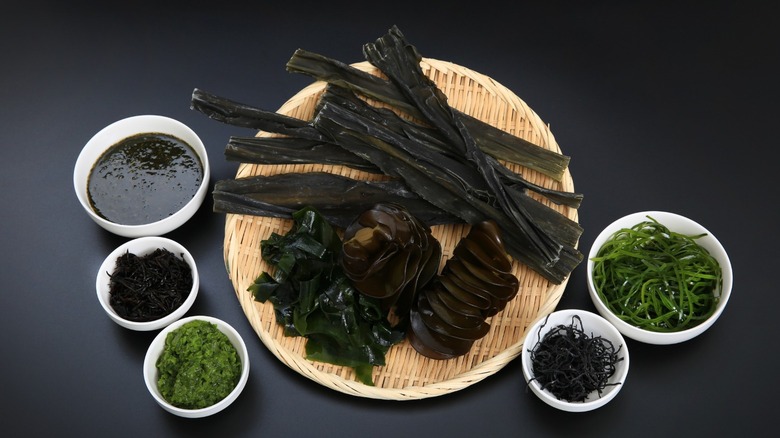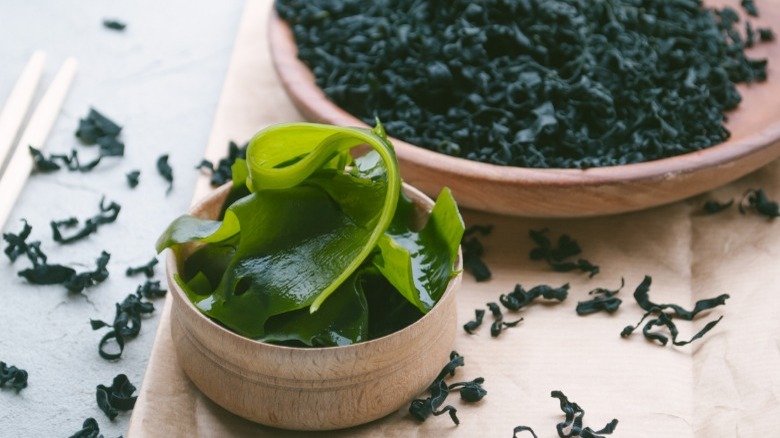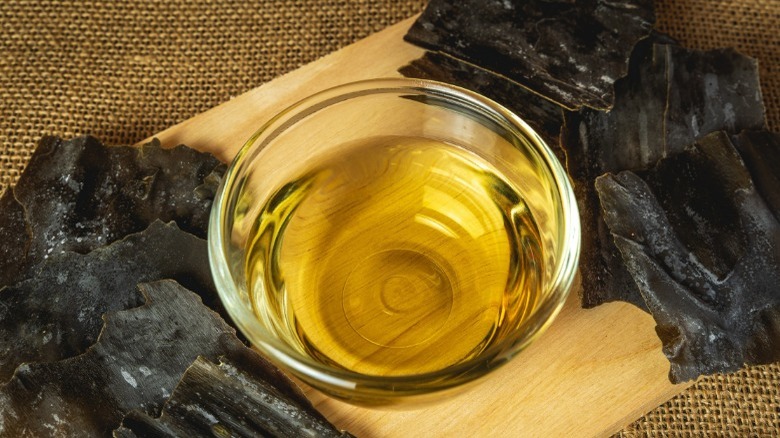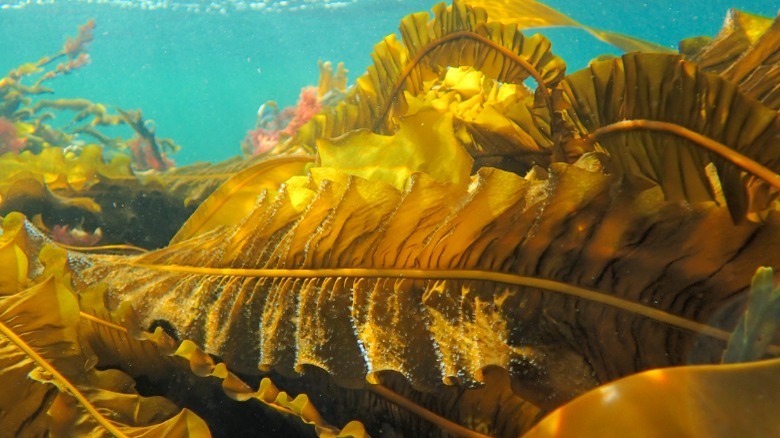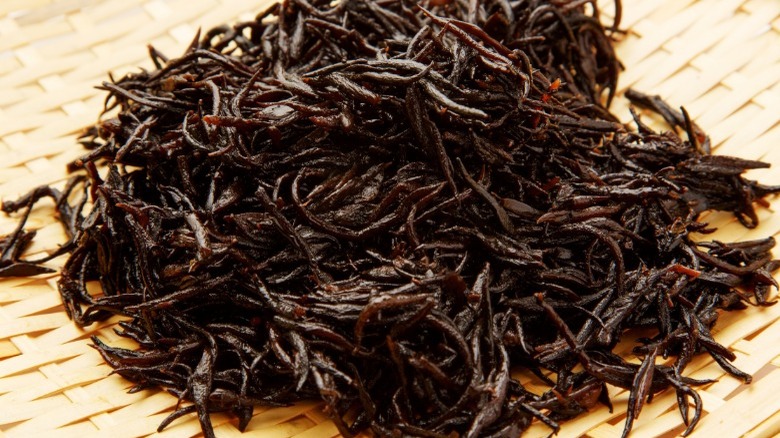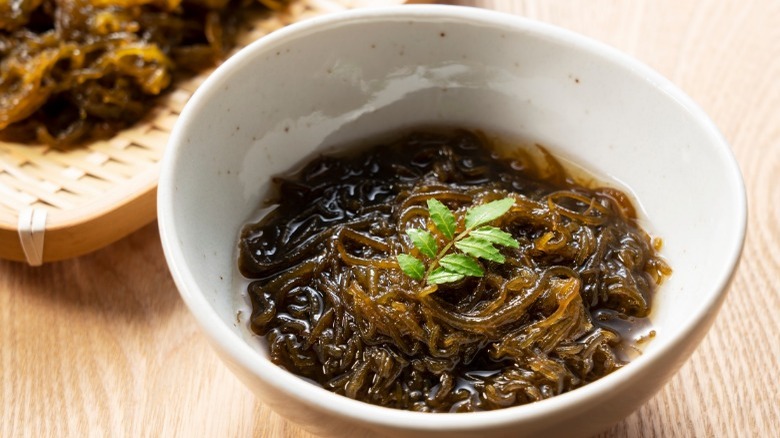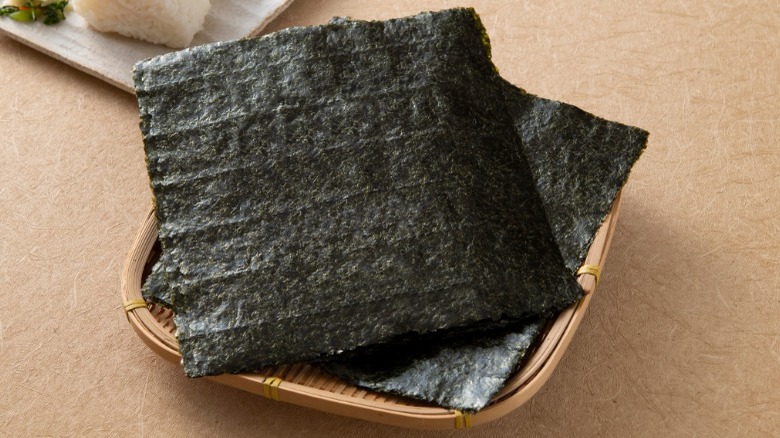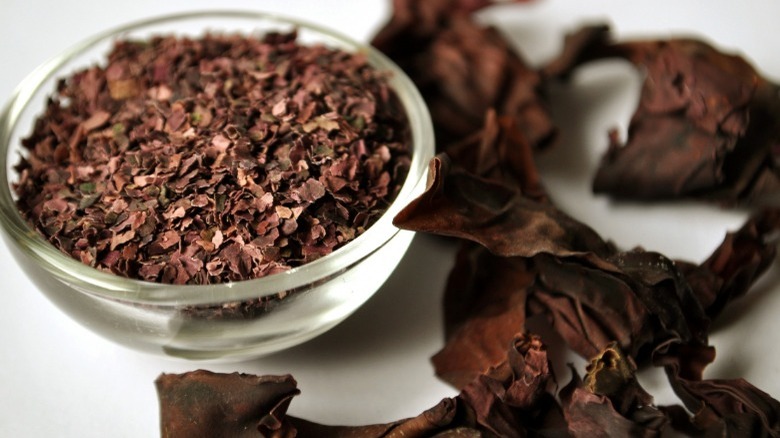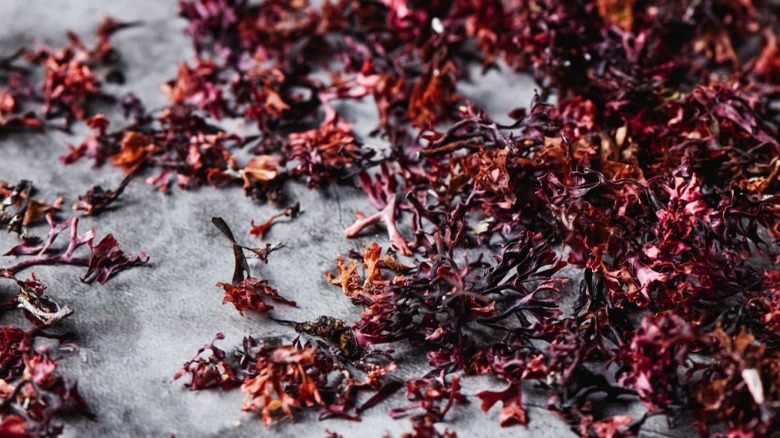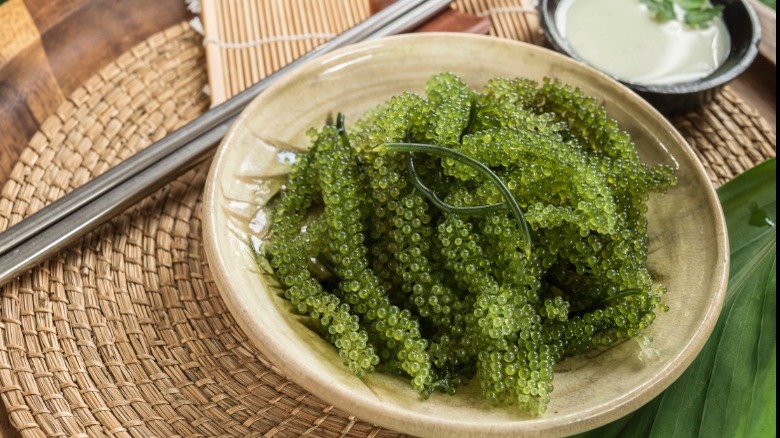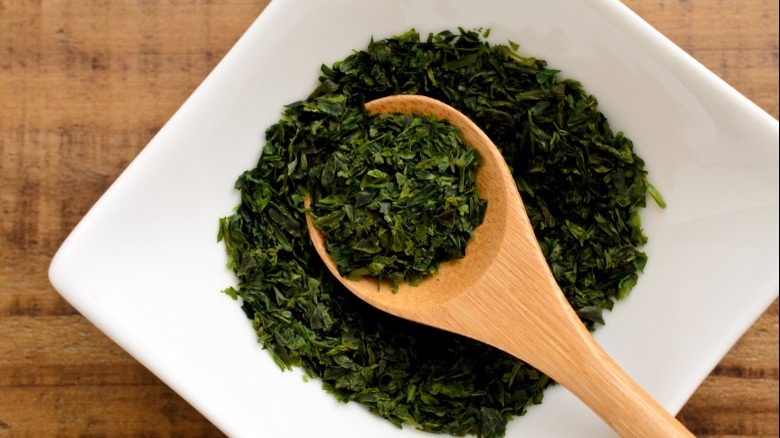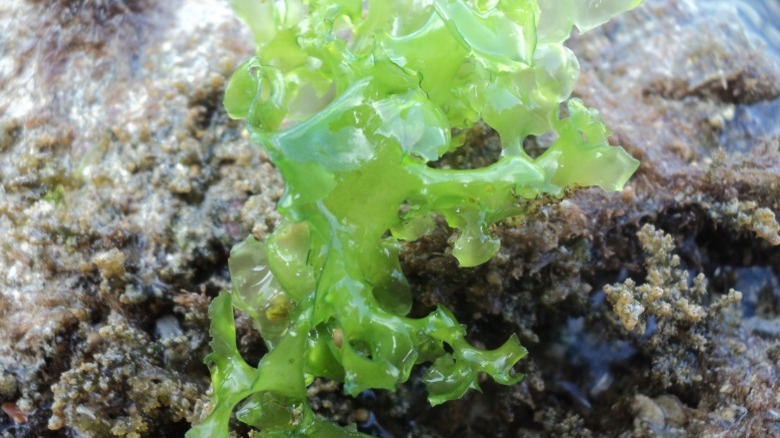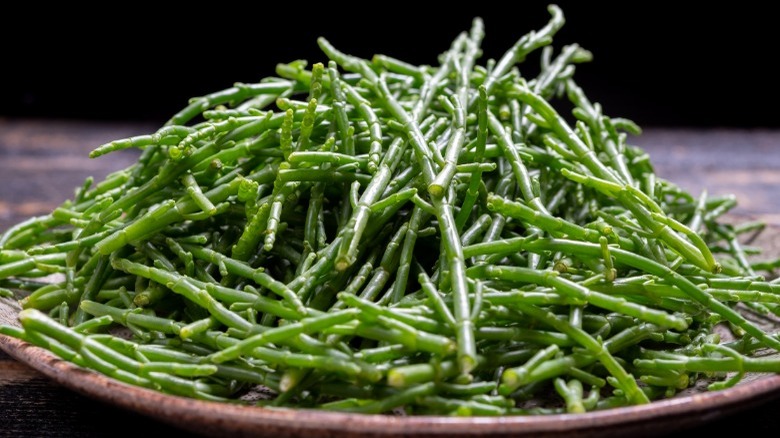12 Types Of Sea Vegetables, Explained
We may receive a commission on purchases made from links.
For those who are not familiar with what western countries typically call "seaweed," the idea of eating a weed from the ocean will seem unappetizing. It is why the senior advisor for the United Nations Global Compact on Oceans, Vincent Doumeizel, wants to change the name of edible ocean plants and algae to "sea vegetables." "Seaweed is clearly not a weed. It is not something unwanted that grows in your garden," Doumeizel told The Telegraph. "It should be called 'sea vegetables,' which is the exact translation of the word in Japanese and Korean."
While more common in Asian cuisines, sea vegetables have historically also been eaten in many coastal nations such as in Polynesia, the Caribbean, and Europe (via the Smithsonian). There's also been a renewed interest in them in the West for several reasons. First, sea vegetables are low in calories, high in protein and unsaturated fatty acids, and packed with vitamins and minerals according to Phys.org. Along with their nutritional value, they can be produced in an easy and sustainable way, which makes them an invaluable food source.
Taste, however, is probably what the uninitiated are most curious about. Sea vegetables impart an umami flavor, and they can elevate the taste of even simple food that people make at home such as eggs, salads, and popcorn. Here is a list of some sea vegetables to try, from the familiar nori that can be found at Costco to some unfamiliar options that are worth tracking down.
Wakame
Wakame is a type of kelp that is native to Japan, Korea, and China, but shows up in various parts of the world as one of the worst invasive species (via the National Park Service). Despite its reputation as an aggressive ocean invader, it has a mild, faintly sweet flavor and a soft, silky texture.
Wakame is usually found in its dried form, so it will need to be soaked in water for about 10 minutes before adding to dishes and eating. As wakame will expand in the water, a little goes a long way, and you may also want to cut it into smaller pieces before soaking. If you want to bring out its almost neon green color, blanch it in boiling water for a couple of seconds and then soak it in ice water.
People's first exposure to wakame is probably in miso soup or a seaweed salad that has been dressed in soy sauce, rice or plum vinegar, and sesame oil. If you want to shake up your standard salad blend, swap it in for land greens.
Kombu
A member of the kelp family, kombu comes mainly from Hokkaido, Japan and it is known as "dasima" in Korean and "haidai" in China (via MasterClass). It has a mushroom-like, briny taste that is most famously used in dashi, the traditional Japanese stock that is the base for soups such as miso soup, noodle bowls such as ramen, and hot pots such as shabu shabu.
Dashi stock can be used in non-traditional ways as well. It can be used to poach eggs for added flavor as well as in vinaigrettes and brines. The kombu strips by themselves can also add flavor and nutrition to soups, stews, and rice. You can choose to discard the kombu after cooking, or chop it up and add it back into the pot for some extra texture.
Kombu can also help people digest beans more easily without getting gassy. According to The Washington Post, kombu contains enzymes that break down raffinose sugars in beans that can cause intestinal discomfort.
Alaria
Alaria is a brown algae that is also known as winged kelp and Atlantic wakame, or dabberlocks and badderlocks in the U.K. (via Seaweed Solutions). It is found in cold waters all over the world in Europe, North America, and Asia. The taste is described as salty with a bit of nuttiness according to Maine Coast Sea Vegetables.
Just like all sea vegetables, Maine Coast Sea Vegetables warns that you should always get responsibly-sourced alaria that did not simply wash up onshore. It is available in various dried forms, including whole leaves, powder, and granules.
The whole leaf is hard and crunchy but softens as you chew it and can be eaten as a snack. The powder can be used in broths and soups while the granules can be used as seasoning. As the name Atlantic wakame implies, alaria can also be used as a substitute for Asian wakame in miso soup, but will need to cook for longer as alaria is tougher as per Maine Coast Sea Vegetables.
Hijiki
Hijiki is a brown algae that grows along the Japanese coastline, and there are two types of it — the nagahijiki, which comes from the stems, and the mehijiki, which comes from the leaves (via Kurakon). Fresh hijiki is maroon-colored and will turn blacker as it dries. Just like wakame, dried hijiki will expand when it is put into water and also become soft and tender.
Hijiki's taste is earthy and less briny and salty compared to other sea vegetables like nori, wakame, and kombu. Prepare a kale hijiki salad with cabbage and yuba as a side dish or consider adding the algae to stir fries and rice dishes. MasterClass also recommends adding it to soba noodles, onigiri rice, and on top of scrambled eggs. Hijiki is sold in Asian markets in the West and on Amazon. Before preparing, make sure to rehydrate dry hijiki in water for at least 10 minutes.
Mozuku
Mozuku is a brown algae from the warm waters of Okinawa, Japan, which is where the longest-living people in the world call their home. Lauren Manaker, a South Carolina-based registered dietician, suggested to Well + Good that one of the secrets to the longevity of the island's inhabitants may be the consumption of the brown algae which contains fucoidan, a compound that is not present in red and green algae. She explains, "Fucoidan has been shown to have antioxidant, anti-tumor, anti-coagulant, anti-thrombotic, anti-viral, and anti-inflammatory effects."
Mozuku has the slippery and slimy texture that Japanese people love in their foods such as natto, which is fermented soy beans, and yamaimo, a Japanese mountain yam (via The Japan Times). That is why they like to eat raw mozuku dressed in sweet vinegar, or double the sliminess by eating it with natto. For those who are not used to such textures, it may be easier to enjoy mozuku in soups or fried in the form of tempura.
Nori
Also known as laver and "gim" in Korean, nori is probably the most well-known sea vegetable as it is readily available across the globe. The red algae grows in cold water in both the Northern and Southern Hemispheres and is then shredded, spread thin, dried, cut into sheets, and roasted (via Best Health).
While you may not be making sushi rolls at home, there are many ways that the crispy, briny nori can be incorporated into your cooking. Best Health recommends adding nori to seasonings, dips, and noodle dishes or garnishing soups and stir fries. If you want sushi that's more portable and less complicated to make, you can use the sheets like a tortilla and make a sushi burrito. Nori also comes in seasoned varieties in individual packs that can be eaten as a snack.
To ensure your nori stays fresh, make sure to keep it in an airtight container or put it in the freezer. If you want to toast your nori to bring out its flavor even more or revitalize nori that's been out too long and has become chewy, you can use your stove burner. Using tongs, hold the nori above the burner for a few seconds on both sides until there are spots that turn a darker green color.
Dulse
Dulse is a red algae that grows in the northern Atlantic and Pacific coasts that has historically been a part of Scottish, Welsh, and especially Irish diets (via the BBC). During the Irish Potato Famine of the 1840s, dulse was collected to boil and turn into a pulpy porridge or dried in the sun to turn into salty chips. While dulse had been abandoned as food once conditions improved, the BBC notes that there has been a resurgence of interest in this sea vegetable internationally due to its bacon-like flavor. "Fresh dulse is actually quite sweet, but the longer you age it, the saltier it gets," Chef Chris Fearon, who was a winner of BBC's "Great British Menu," told the BBC. "Yet, when you pan-fry it, it has a really interesting, nutty, smoky flavor — almost like bacon."
As a vegan bacon substitute, dulse has been found in DLTs (the dulse, lettuce, and tomato equivalent to BLTs) and Brussels sprout dishes that try to mimic the trendy restaurant appetizer. For home cooking, Great British Chefs suggests that dulse in its dried, ground form can be used to season meats like lambs and burgers and added to sauces, marinades, and rubs.
Sea moss
Sea moss is the general name of a variety of red algae that is found all over the world, and is known by "ogonori" or "ogo" in Japan and Irish moss in Jamaica. In the Philippines, it is used in agar, which is a vegan gelatin substitute. In the Caribbean, sea moss is combined with milk, nutmeg, and cinnamon for a smoothie-like beverage that is consumed during special occasions. In Indonesia and Malaysia, it is blanched and added to salads and boiled in fruit juice to make a pudding, and is also found in poke bowls in Hawaii.
In the U.S., it has become a health and beauty trend as influencers like Hailey Bieber and Kim Kardashian have touted the benefits of smoothies that contain sea moss gel. Forbes notes that along with the gel, sea moss can be consumed as capsules, gummies, and powders. Sea moss is also commonly harvested for carrageenan, which is a commercial thickener that is responsible for the thick, creamy texture of foods such as pudding, tapioca, and ice cream. If you can find raw sea moss, its thickening ability can also be used in home cooking for sauces, stews, jams, and other foods. "Raw sea moss needs to be washed, soaked, and blended," Amy Gorin, a registered dietician nutritionist based in New York, tells Well + Good. "Then, it can be used as a thickening agent for recipes such as smoothies, cakes and soups."
Umibudo
Umibudo is a type of green algae that grows in Japan, Vietnam, and the Philippines and is also known as sea grapes and green caviar because of its appearance as per Phys.org. It has a salty taste and bursts in your mouth like caviar does. As fresh umibudo has a short shelf life, it is commonly packed in seawater as dehydrated umibudo even in Japan. Once it soaks in fresh water for a few minutes, it can be enjoyed in exactly the same way as fresh ones according to Tsunagu Japan.
Unlike many of the sea vegetables on this list, umibudo is typically not cooked as it will ruin the texture. Tsunagu Japan suggests enjoying it raw while dipping it in a ponzu sauce, eating it with sashimi, and having it as a vegan alternative to caviar on sushi.
In Bremen, Germany, umibudo has been studied as a sustainable food source that humans can cost-effectively double its antioxidant amounts through targeted irradiation. "They are easy to reproduce and grow quickly," said Dr. Karin Springer, co-author of the study (via Phys.org). "Sea grapes could therefore find a place on German menus as a source of protein, antioxidants and other nutrients."
Aonori
Despite its name, aonori should not be confused with nori. Nori is from a type of red algae, looks almost black in color, and is more commonly used as a for other foods. Aonori, on the other hand, is from a type of green algae, has a much brighter green coloring, and is available in a dried, flaked or powdered form according to MasterClass. Aonori offers a more pronounced briny and earthy flavor than nori, and features an aroma that is similar to matcha green tea powder.
As a seasoning or garnish, aonori shows up in many Japanese dishes, such as yakisoba (stir-fried noodles), takoyaki (fried octopus balls), and okonomiyaki (a savory pancake). It is also a key ingredient, along with sesame seeds and dried bonito flakes, of furikake seasoning, which is used on everything from fish to omelets to rice and roasted vegetables. MasterClass also recommends adding aonori to dashi stock, tempura batter, and stir fries.
Ulva lactuca
Ulva lactuca is a green algae that is also known as green lettuce. According to Seaweed Solutions, it is grown all over the world. Like land lettuce, it is a bright green color in its raw form, but when it is dried, it can turn white or black. It has historically been eaten in Great Britain, Ireland, Scandinavia, China, and Japan. According to Maine Coast Sea Vegetables, it has also been used as a "poor man's nori" in Japan as it is less expensive than the popular seaweed.
Ulva lactuca's leaves in raw form or rehydrated from its dried form can be tossed in a salad of other sea vegetables or land greens. They will have a crunchy, smooth, and slimy texture, and Maine Coast Sea Vegetables describes its taste as salty and comparable to sorrel. When it is dried into flakes or powder, however, ulva lactuca imparts a bitter, truffle-like flavor that can be used as a seasoning in soup or salads.
Sea beans
While all the other sea vegetables on this list have been algae, sea beans (also known as samphire, glasswort, pickleweed, and sea asparagus) are actually sea succulents (via Hakai Magazine). They thrive in salt marshes and thus, can grow anywhere in the world. According to BBC Good Food, sea beans are very salty, so while they can be eaten raw if they're thoroughly rinsed, it is better to fry them briefly in butter or blanch it in unsalted water.
In Turkey, blanched sea beans are tossed in olive oil and garlic while the shoots are added to pasta dishes in Italy and omelets and terrines in France (via Hakai Magazine). For home cookers, fresh sea beans can be kept in the refrigerator for two to three days while covered in a damp cloth (the roots and stems should be discarded). Great British Chefs recommends pairing them with fish, shellfish and lamb, as well as frying the sea succulent in a tempura batter.
